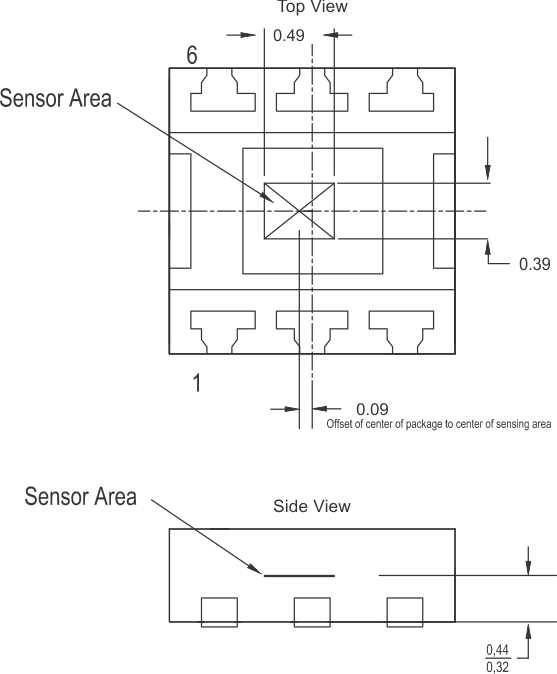ZHCSCY7C July 2014 – November 2017 OPT3001
PRODUCTION DATA.
- 1 特性
- 2 应用
- 3 说明
- 4 修订历史记录
- 5 Pin Configuration and Functions
- 6 Specifications
-
7 Detailed Description
- 7.1 Overview
- 7.2 Functional Block Diagram
- 7.3 Feature Description
- 7.4 Device Functional Modes
- 7.5 Programming
- 7.6
Register Maps
- 7.6.1
Internal Registers
- 7.6.1.1
Register Descriptions
- 7.6.1.1.1 Result Register (offset = 00h)
- 7.6.1.1.2 Configuration Register (offset = 01h) [reset = C810h]
- 7.6.1.1.3 Low-Limit Register (offset = 02h) [reset = C0000h]
- 7.6.1.1.4 High-Limit Register (offset = 03h) [reset = BFFFh]
- 7.6.1.1.5 Manufacturer ID Register (offset = 7Eh) [reset = 5449h]
- 7.6.1.1.6 Device ID Register (offset = 7Fh) [reset = 3001h]
- 7.6.1.1
Register Descriptions
- 7.6.1
Internal Registers
- 8 Application and Implementation
- 9 Power-Supply Recommendations
- 10Layout
- 11器件和文档支持
- 12机械、封装和可订购信息
12 机械、封装和可订购信息
以下页中包括机械封装、封装和可订购信息。这些信息是针对指定器件可提供的最新数据。数据如有变更,恕不另行通知和修订此文档。如欲获取此数据表的浏览器版本,请参阅左侧的导航。
12.1 关于焊接和处理的相关建议
OPT3001 通过 JEDEC JSTD-020 认证,适用于三种回流焊操作。
请注意:温度过高会导致器件褪色并影响光学性能。
有关焊接热规范和其他详细信息,请参见应用报告《QFN/SON PCB 连接》(SLUA271)。如果必须从 PCB 上移除 OPT3001,请拆下此器件后不再重新连接。
处理 OPT3001 时需要像处理大多数光学器件那样谨慎操作,确保光学表面保持洁净无损伤。更多详细建议,请参见Do's and Don'ts部分。为获得最优光学性能,完成焊接后必须清理焊剂和任何其他碎屑。
12.2 DNP (S-PDSO-N6) 机械制图
 Figure 36. 引脚 1 的封装方向视觉基准
Figure 36. 引脚 1 的封装方向视觉基准(顶视图)
 Figure 37. 显示感测区域位置的机械制图
Figure 37. 显示感测区域位置的机械制图(顶视图和侧视图)